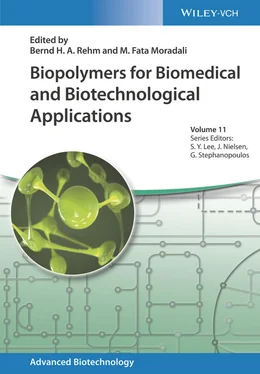Fungal chitin can also be found covalently linked to β‐glucans to form chitin complexes such as chitin–glucan complex (CGC) [208,213]. Among the microbial cultures that can be used as chitin/chitinous polysaccharide sources are filamentous fungi (e.g. Aspergillus niger , Aspergillus fumigatus , Rhizopus oryzae , Mucor rouxii ) [213,217], mushrooms (e.g. Ganoderma lucidum , Agaricus bisporus , Schizophyllum commune ) [218,221], and yeasts (e.g. Saccharomyces cerevisiae , Komagataella ( Pichia ) pastoris , Candida albicans ) [216,222–224]. The chitinous polysaccharide extraction from fungal cell walls can be performed with mechanical and/or nonmechanical methods. Some examples of mechanical methods are high‐pressure homogenization, bead mill, or ultrasound, while the nonmechanical methods include the alkaline hydrolysis (with NaOH or KOH as solvents) or enzymatic treatments [225].
Chitosan is the most known chitin derivative, obtained from the deacetylation reaction of chitin, in high alkali and temperature conditions or by enzymatic hydrolysis ( Figure 2.5) [226,228]. Depending on the alkaline treatment performed for fungal cell‐wall lysis, the extraction procedure can also result in the extraction of chitosan or chitosan–glucan complex (ChGC) [215,221,229,230].
2.7.2 Properties of Chitinous Polysaccharides
Chitin is a crystalline and hydrophobic polysaccharide with a molecular weight of 1 to 2 × 10 5Da [226,227,231,232]. Chitinous polysaccharides, such as CGC, also have a similar molecular weight (4 to 5 × 10 5Da), but since they are covalently linked to β‐glucans, they present an amorphous nature [222]. Chitin and chitinous polysaccharides are insoluble in water and in most of organic solvents. The most common solvent systems used for these biomaterials are N , N ‐dimethylacetamide/LiCl, NaOH/urea, LiOH or NaOH at low temperatures, or, more recently, ionic liquids [227,231,233]. In opposition, chitosan is soluble in diluted organic acids such as acetic, formic, or hydrochloric acid solutions [227,231]. Chitosan is also characterized for its high deacetylation degree (DD), usually above 50% and a molecular weight of 2 × 10 4to 2 × 10 5Da [216,234].
Chitin, chitosan, and their complexes are also known by their biological activity. Behind being biodegradable and biocompatible, these polysaccharides also have antimicrobial, anti‐inflammatory, antioxidant, and antitumoral activity [235,237]. Moreover, fungal chitosan also has emulsifying properties with vegetable oils [214].
2.7.3 Applications of Chitinous Polysaccharides
In application development of microbial chitinous polysaccharides, several polymer structures can be constructed from nanofibers or nanoparticles for food formulations or biomedical devices, hydrogels for drug delivery systems or films, and scaffolds/composites or tablets for pharmaceutical formulations [155,215,238,239].
The diversity of polymer structures and their physicochemical and biological properties have attracted an increasing interest on these polysaccharides for several and diverse areas, such as biomedical devices, pharmaceutical industry, food products, cosmetic formulations, agriculture, and textiles or even on wastewater treatment (Table 2.4) [234,235,241].
Table 2.4Microbial chitinous polysaccharide properties and applications.
| Polysaccharide |
Source |
Properties |
Applications |
References |
| Chitin |
Saccharomyces cerevisiae |
Antifungal |
Disease resistance against Botrytis cinerea infection in tomato fruit |
[224] |
| Chitin |
Rhizopus oryzae |
Anti‐hepatotoxic effect, antioxidant |
Pharma formulation to prevent the liver damage against paracetamol and increase the body's defense system |
[240] |
| Chitosan |
S. cerevisiae, Rhizopus arhizus |
Metal ion sorption |
Wastewater treatment |
[241] |
| Chitosan |
Aspergillus niger |
Biocompatibility and swelling capacity |
Hydrogel support for controlled release of the histidine analogous, betahistine |
[215] |
| Chitin–glucan complex |
A. niger |
Anticholesterol |
Fiber with potential therapeutic utility for coronary heart diseases, obesity, and diabetes |
|
| Chitin–glucan complex |
A. niger |
Heavy metal and nucleotide absorption capacity |
Food additive |
[246] |
| Chitin–glucan complex |
A. niger |
Water absorption capacity, antiaging effect |
Cosmetic formulation for antiaging products |
[247,248] |
| Chitin/chitosan–glucan complex |
Schizophyllum commune |
Antibacterial, noncytotoxic, wound healing capacity |
Micro and non‐woven fiber for wound healing |
[229] |
2.7.3.1 Biomedical Applications
Chitin, chitosan, and chitinous polysaccharides have been subject of increasing interest on the biomedical field due to their biocompatibility, biodegradability, and nontoxicity [237]. Moreover, these polysaccharides also have biological activity including anticancer and antibacterial activity [234]. They are also immunostimulating, antithrombogenic, hemostatic, and wound healing [234,235]. These properties make these biopolymers interesting materials for drug delivery systems, tissue engineering, or wound healing products.
Chitin and chitosan can be used as drug/vitamin carriers and excipients in films, hydrogels, or powders for drug delivery systems or ophthalmologic formulations [228,234]. For example, chitosan hydrogels were already used as support for the controlled release of betahistine (a histidine analog) [215] (Table 2.4). Chitosan can also be used in contact lenses for eyes due to its optical clarity, mechanical stability, and wettability [235].
Chitin‐based materials are promising materials for tissue engineering of nerves, blood vessels, or scaffolds for regenerative medicine. These structures have high porosity and structural integrity that promote cell adhesion and encourage cell function as important features for regenerative materials [228,235]. These polysaccharides also contribute to the activation of immune system, which was already demonstrated in some in vitro and in vivo trials [249].
Chitinous polysaccharides are also commonly used as wound healing fibers [229] (Table 2.4). Some chitin and chitosan products are already commercially available, for example, in form of sponges, nonwoven dressings for burns or skin abrasions, and several other injuries, as well as gels for internal wounds [228].
2.7.3.2 Pharmaceutical Applications
Similar to biomedical applications, chitinous polysaccharides are also interesting materials for the pharmaceutical industry, due to its antimicrobial, antitumor, antioxidant, anticholesterol and hemostatic effect, and wound healing [250]. Chitin extracted from R. oryzae was shown to have anti‐hepatotoxic effect, preventing the liver damage against paracetamol and contributes to the increasing of body's defense system [240]. A. niger CGC was shown to prevent the early development of atherosclerosis in in vivo studies [251]. In pharma applications, these biomaterials can be used as carriers of encapsulated drugs for drug delivery devices, vaccine adjuvants, or an excipient powder that can be used as binder, disintegrator, and/or a lubricant agent [234,235,252].
2.7.3.3 Food Applications
Читать дальше












